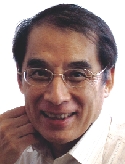Akira Tonomura
DOI: 10.1063/PT.3.1957
Akira Tonomura, a Hitachi fellow who developed electron holography and a group director at the RIKEN Advanced Science Institute, passed away in Hidaka, Japan, on 2 May 2012 after his fight against pancreatic cancer.
Tonomura was born on 25 April 1942 in Hyogo Prefecture, Japan. He graduated from the department of physics at the University of Tokyo in 1965 and immediately joined the Central Research Laboratory of Hitachi Ltd. Tonomura was motivated to join the lab because of Hiroshi Watanabe, who, with a single electron micrograph, proved the Bohm–Pines plasma oscillation theory by using electron energy-loss spectroscopy. On the recommendation of Watanabe, Tonomura pursued research with electron beams to achieve holography, invented earlier by Dennis Gabor. Tonomura frequently communicated with Gabor, who encouraged him to realize aberration correction using electron holography, something that Gabor himself wanted to do, but he lacked a coherent electron source when he was doing his own research.
After demonstrating the basic principle of holography using a conventional electron microscope, Tonomura started developing an electron microscope with a field-emission electron source invented by Albert Crewe. Tonomura intended to use the source, which has a brightness several orders of magnitude higher than that of a conventional thermionic-emission source, to generate a coherent electron wave. It was during that period that Tonomura went to work as a research scientist with Gottfried Möllenstedt at the University of Tübingen in Germany; Möllenstedt had invented a device called an electron biprism for interference experiments. The experience provided much inspiration for Tonomura’s future work. After several years of technical development, he achieved high coherence in his electron beams.
Tonomura then went on to use electron holography to observe the paradoxical quantum world, and his 1986 verification of the Aharonov–Bohm (AB) effect is one of his singular achievements. Yakir Aharonov and David Bohm had stated in 1959 that the vector potential is itself a fundamental physical entity and can affect a charged particle in a region where there is no magnetic field and therefore no force acting on the charged particle. The significance of the AB effect was renewed when Tai Tsun Wu and C. N. Yang recognized the effect as an experimental manifestation of the nonintegrable phase factor; they introduced and generalized it to a non-abelian gauge field to explain different interactions in a unified manner. (For a historical review of the AB effect, see the article Tonomura wrote with Herman Batelaan, Physics Today, September 2009, page 38
To verify the AB effect, Tonomura and his colleagues fabricated a tiny toroidal ferromagnet covered with a layer of superconducting niobium to perfectly shield the magnetic field. They then measured a phase difference between the electrons that traveled through the central hole of the toroid and those outside it. Although the electrons had only progressed through regions free of electromagnetic fields, there was an observable effect produced by the existence of vector potentials. To create a new trend of applying cutting-edge engineering to the various issues in quantum mechanics, an international symposium on fundamental quantum mechanics was established in 1983 after Tonomura’s first experiment to verify the AB effect; many international conferences with the same scope have since been held.
Tonomura’s experiment in 1986 showed single-electron buildups of electron wave interference fringe patterns. It revealed the dual nature of electrons and was described by Physics World magazine as the world’s most beautiful physics experiment, ranking above the historical experiments of Galileo Galilei and Robert Millikan.
Throughout his career, Tonomura worked in an industrial research laboratory. He also held concurrent appointments as the group director at RIKEN and principal investigator at the Okinawa Institute of Science and Technology. At both institutions, he led national projects in electron holography aimed at a deeper understanding of quantum effects and explored field distributions in magnetic and superconducting matter. In 2010 he became the core researcher for “Development and Application of Atomic-Resolution Holography Electron Microscope,” a project of the Funding Program for World-Leading Innovative R&D on Science and Technology and funded by the Japanese government. However, he passed away before fulfilling his dream.
One notable attribute of Tonomura was his strong will to complete his research. In his first experiment to verify the AB effect in 1982, many other researchers pointed out problems. But with advice from Yang, he conceived of the experiment using the toroidal ferromagnet. Despite its being a difficult experiment, Tonomura allowed no compromise, and he finally succeeded. I remember him saying a scientist should aim for a research target so high that if he cannot succeed, then he can confidently say, “No one else in the world can.” In just that way, he was unrelenting in his research, but to the people around him, he was a kind and thoughtful man. Officially and personally, he looked after researchers to ensure they had a good research environment.
When he was first diagnosed in the spring of 2011, even as he sought the best treatment for his illness, Tonomura continued to think about his research and maintained his pride as a researcher until the end.
I am deeply saddened for the premature departure of such a warm and kind colleague and such a great scientist. I have the deepest respect for the man and his many achievements.

Akira Tonomura

More about the Authors
Nobuyuki Osakabe. Central Research Laboratory, Hitachi Ltd, Tokyo.
